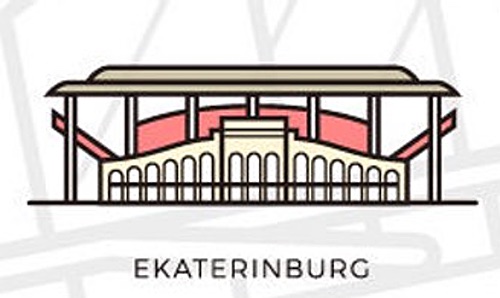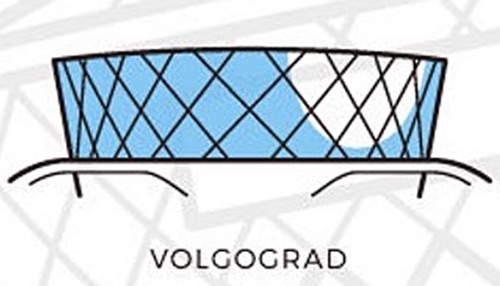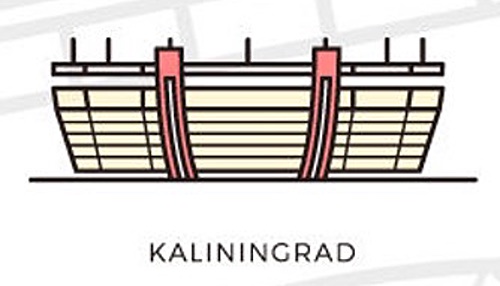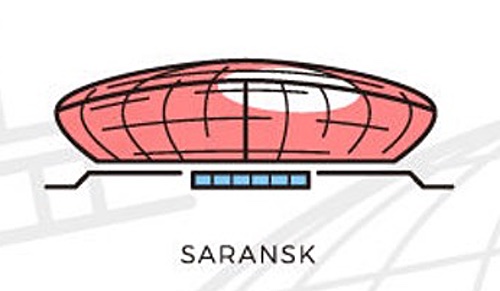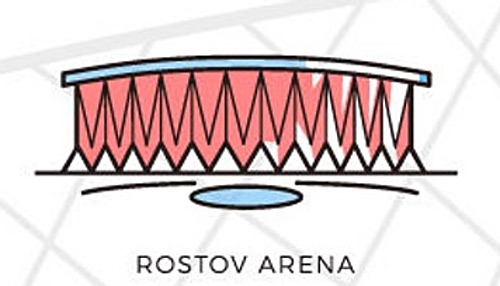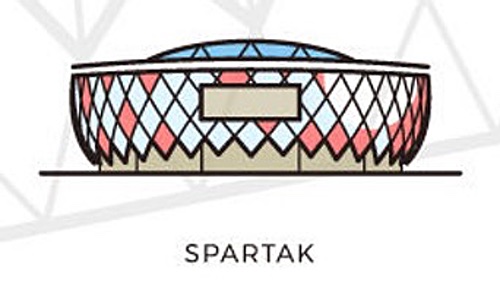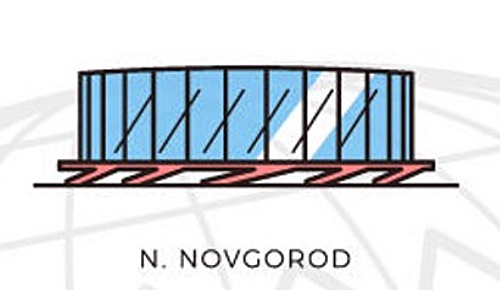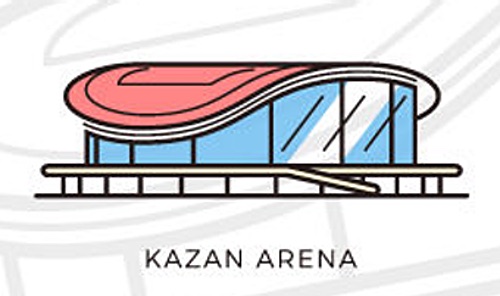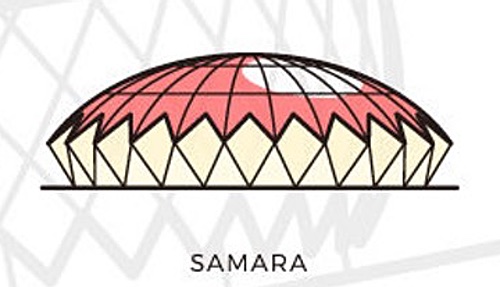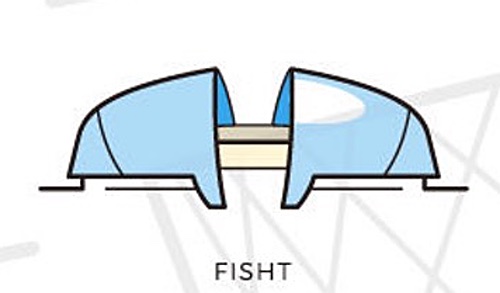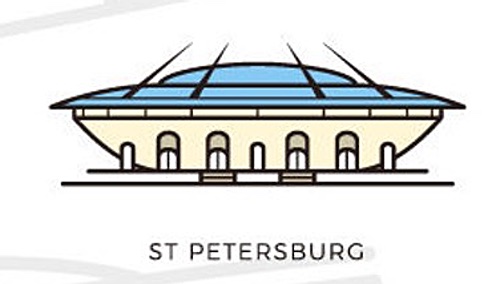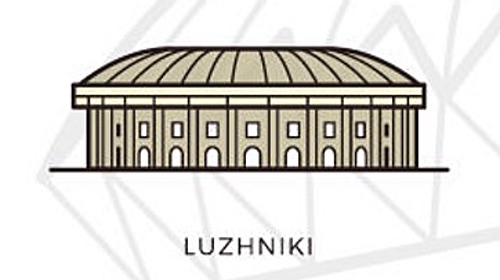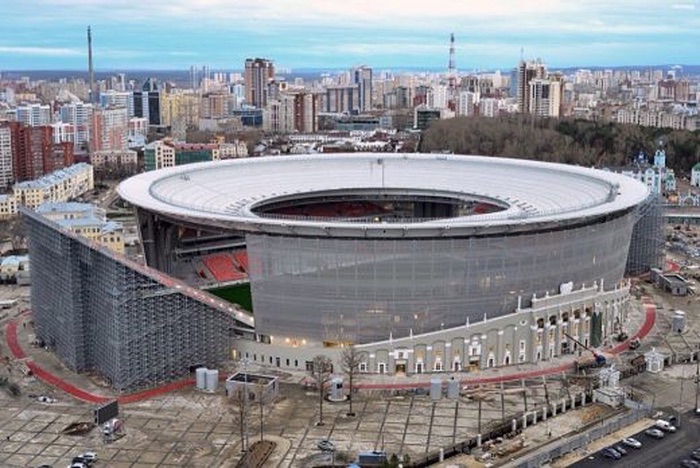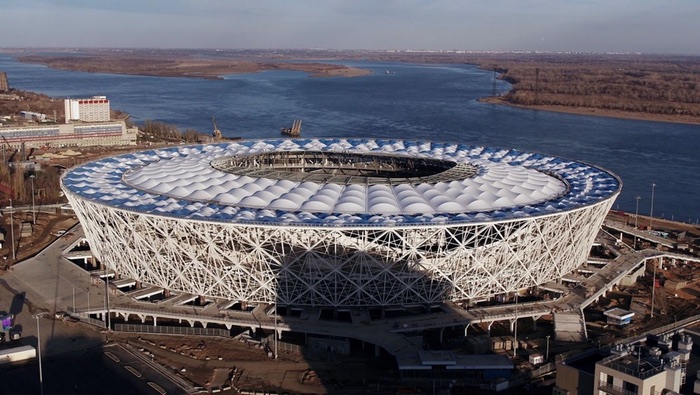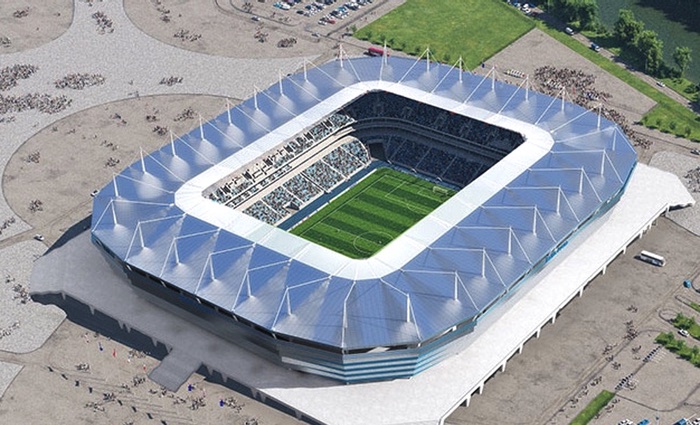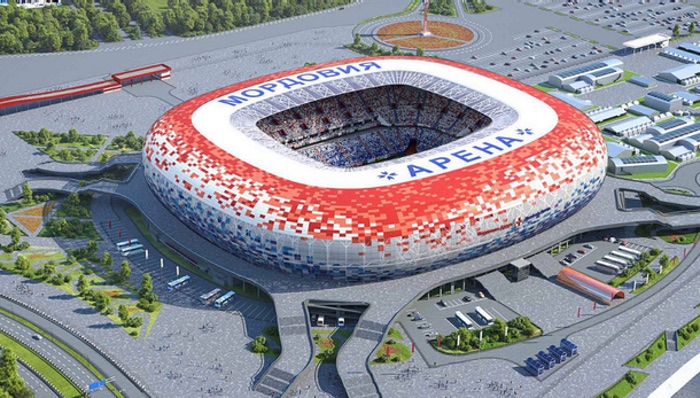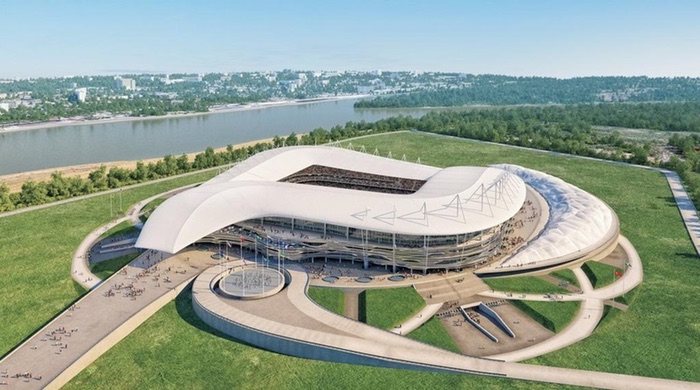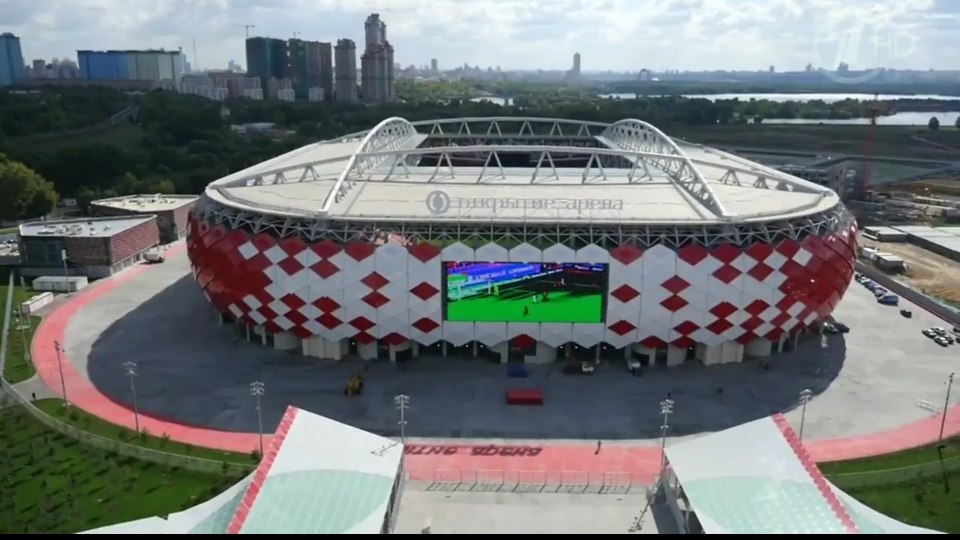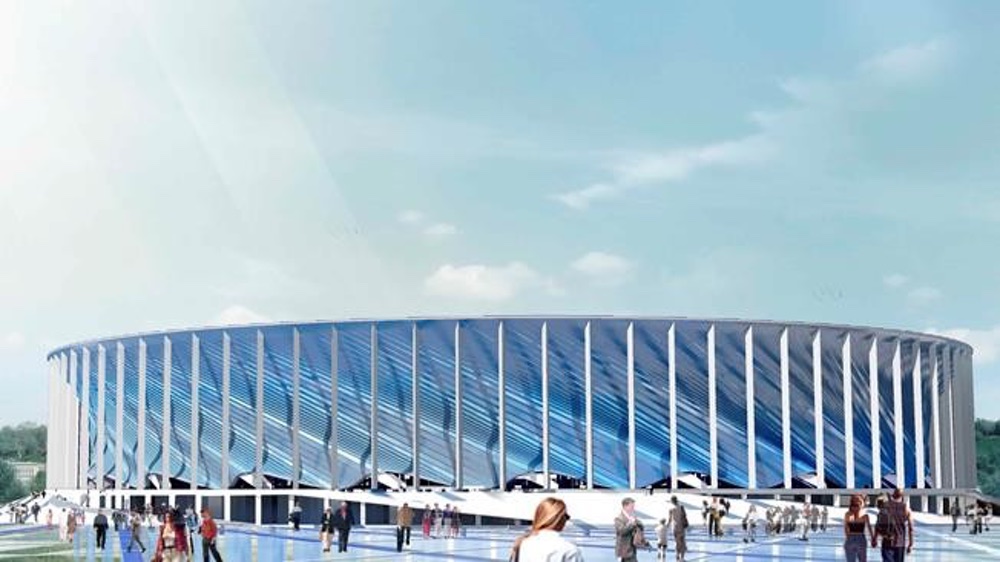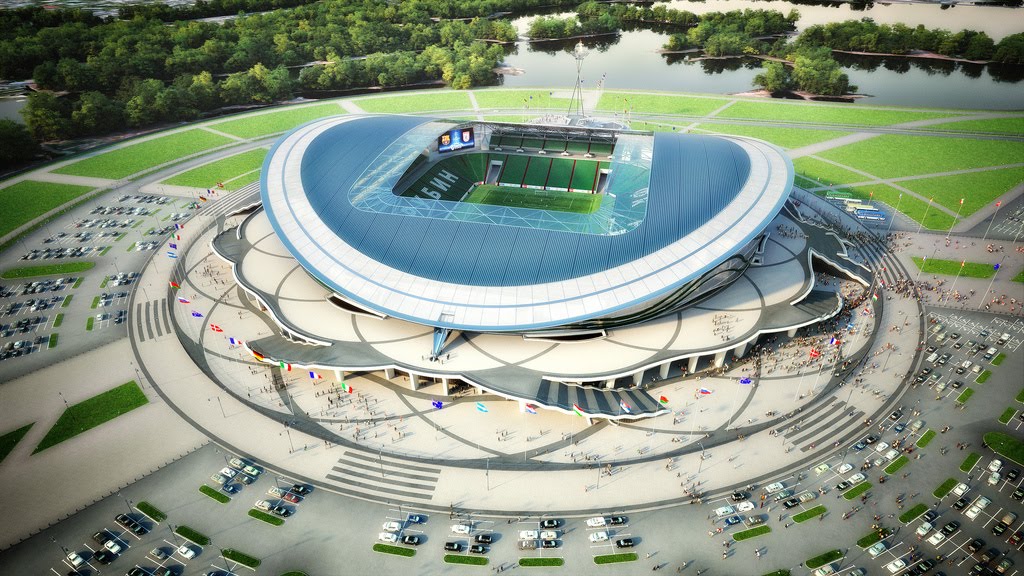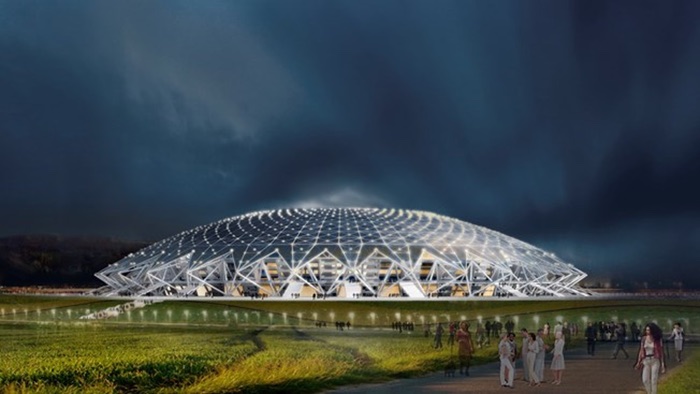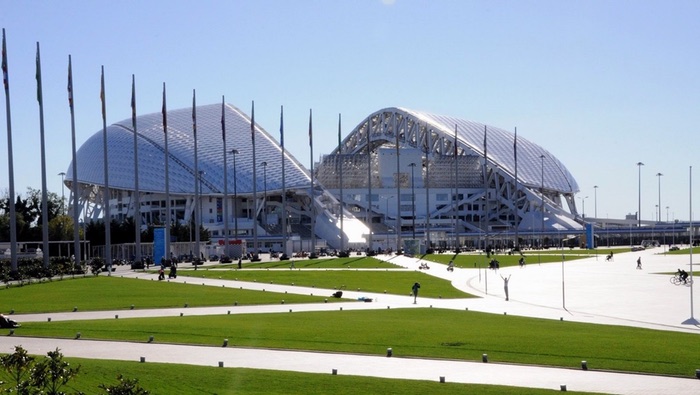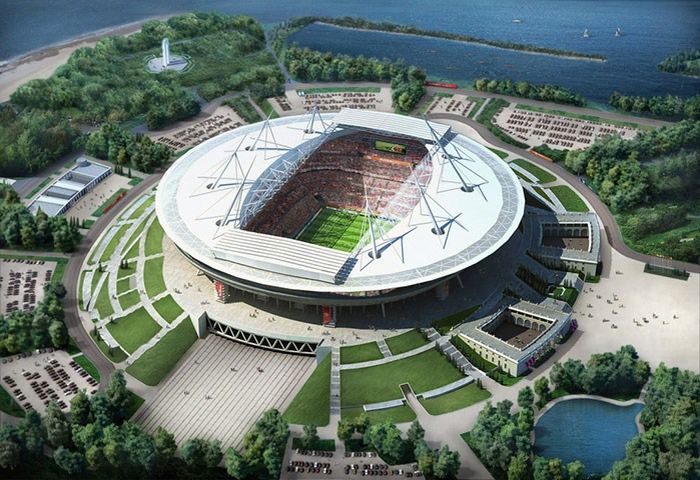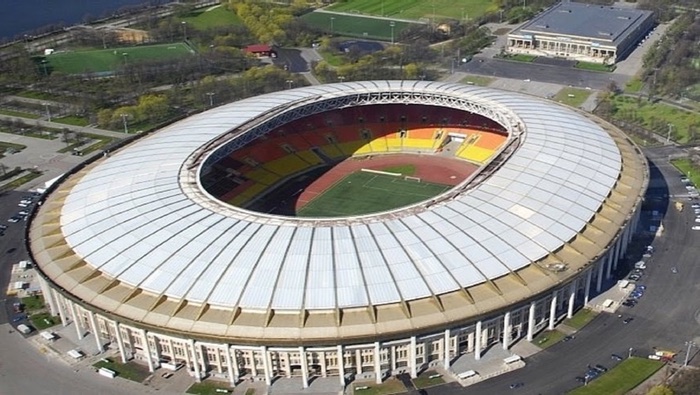
The 12 Host Venues
Background Descriptions
And a little bit of history …..
IBO Author : Spot51
Ekaterinburg
Central Stadium
Russia's 4th largest city is the most Easterly of the 2018 venues. It lies close to the Urals where Europe becomes Asia. The area has been settled since the Neolithic but the first city on this site came into being in the reign of Peter the Great (1723) when the world's largest iron production plant was established.
Ekaterinberg has remained a major industrial city but being on major East-West trade routes it became the "Window on Asia" and grew in commercial, administrative and military importance. Following the revolution of October 1917, the Tsar and his family were imprisoned here and the following summer, with the White Russians closing in, they were executed by the Bolsheviks. The city fell but was recaptured by the Red Army in 1919.
Renamed Sverdlovsk during the communist era, the city continued as an industrial hub. In WW2 much of the USSR's war production moved here, beyond the range of the Luftwaffe. During the 1991 coup, the city remained loyal to Yeltsin (who was born here) and was soon renamed Ekaterinberg.
The city's football club was founded in 1930 and the Central Stadium built in 1953. Ural Yekaterinburg play in Russia's Premier league and their ground has been extended to seat 36K during the tournament.
Central Stadium hosts 4 group matches:
1. Egypt v Uruguay
2. France v Peru
3. Japan v Senegal
4. Mexico v Sweden.
Ekaterinberg has remained a major industrial city but being on major East-West trade routes it became the "Window on Asia" and grew in commercial, administrative and military importance. Following the revolution of October 1917, the Tsar and his family were imprisoned here and the following summer, with the White Russians closing in, they were executed by the Bolsheviks. The city fell but was recaptured by the Red Army in 1919.
Renamed Sverdlovsk during the communist era, the city continued as an industrial hub. In WW2 much of the USSR's war production moved here, beyond the range of the Luftwaffe. During the 1991 coup, the city remained loyal to Yeltsin (who was born here) and was soon renamed Ekaterinberg.
The city's football club was founded in 1930 and the Central Stadium built in 1953. Ural Yekaterinburg play in Russia's Premier league and their ground has been extended to seat 36K during the tournament.
Central Stadium hosts 4 group matches:
1. Egypt v Uruguay
2. France v Peru
3. Japan v Senegal
4. Mexico v Sweden.
Volgograd
Pobeda Stadium
The original settlement, at the confluence of the Volga and Tsaritsa rivers, in the mid 16th century became Tsaritsyn. It was initially a trading post but during the 1800s became a major river port and commercial centre and the population expanded greatly. During the Russian Civil War, it was held by both the Soviets and the Whites at various times. In 1925 it was renamed Stalingrad.
Under Stalin, the city became an important industrial area and the enormous tractor plant gained world fame. During WW2, its strategic location due South of Moscow and the major crossing on the Volga made it a target for the German invaders. For over 5 months, from August 1942, the bloodiest battle in history was fought in and around Stalingrad. Some estimates suggest up to 2 million died but by the following Spring the USSR emerged victorious. Whilst not the turning point of the war, the severe losses incurred by the Wehrmacht at Stalingrad necessitated Berlin to bring replacement troops and materiel from the Western Front. During the late summer of 1943, German forces were repulsed at Kursk and from that point onwards the front moved back towards Germany.
In real terms, Stalingrad ceased to exist as a completely new city had to be erected on the site. The enormous loss of life was recognised in memorials and also by twinning with other war-ravaged cities across the globe. The first such agreement was made with Coventry in 1943.
With Stalin dead, Khrushchev renamed the city Volgograd. The population now exceeds 1 million and it remains an important industrial and commercial inland port.
Traktor Stalingrad were founded in 1929. They played in regional leagues until 1988, when as Rotor Volgograd, they finally reached the top flight. Despite being relegated the next season, they were promoted as the USSR collapsed and found themselves in the new Russian Premier League.
Initially they enjoyed success, sparring with Spartak throughout the 90s and finishing as runners-up twice. They regularly qualified for Europe and their finest result was an away-goals win over Manchester United in the 1995/6 UEFA club. The club then ran into financial difficulties and, in 2005, went out of business. The club's reserves continued to play in lower leagues and, as Russia prepared to host the World Cup, became the new Rotor: sadly, further financial mismanagement saw them relegated to the 4th tier in 2015.
With the new 45K capacity Pobeda Stadium being built on the site of the old Central Stadium, Rotor expressed an interest in moving back after the World Cup. Back to back promotions have seen Rotor return to the second division.
Volgograd hosts 4 group matches:
1. Tunisia v England
2. Nigeria v Iceland
3. Saudi Arabia v Egypt
4. Japan v Poland
Under Stalin, the city became an important industrial area and the enormous tractor plant gained world fame. During WW2, its strategic location due South of Moscow and the major crossing on the Volga made it a target for the German invaders. For over 5 months, from August 1942, the bloodiest battle in history was fought in and around Stalingrad. Some estimates suggest up to 2 million died but by the following Spring the USSR emerged victorious. Whilst not the turning point of the war, the severe losses incurred by the Wehrmacht at Stalingrad necessitated Berlin to bring replacement troops and materiel from the Western Front. During the late summer of 1943, German forces were repulsed at Kursk and from that point onwards the front moved back towards Germany.
In real terms, Stalingrad ceased to exist as a completely new city had to be erected on the site. The enormous loss of life was recognised in memorials and also by twinning with other war-ravaged cities across the globe. The first such agreement was made with Coventry in 1943.
With Stalin dead, Khrushchev renamed the city Volgograd. The population now exceeds 1 million and it remains an important industrial and commercial inland port.
Traktor Stalingrad were founded in 1929. They played in regional leagues until 1988, when as Rotor Volgograd, they finally reached the top flight. Despite being relegated the next season, they were promoted as the USSR collapsed and found themselves in the new Russian Premier League.
Initially they enjoyed success, sparring with Spartak throughout the 90s and finishing as runners-up twice. They regularly qualified for Europe and their finest result was an away-goals win over Manchester United in the 1995/6 UEFA club. The club then ran into financial difficulties and, in 2005, went out of business. The club's reserves continued to play in lower leagues and, as Russia prepared to host the World Cup, became the new Rotor: sadly, further financial mismanagement saw them relegated to the 4th tier in 2015.
With the new 45K capacity Pobeda Stadium being built on the site of the old Central Stadium, Rotor expressed an interest in moving back after the World Cup. Back to back promotions have seen Rotor return to the second division.
Volgograd hosts 4 group matches:
1. Tunisia v England
2. Nigeria v Iceland
3. Saudi Arabia v Egypt
4. Japan v Poland
Kaliningrad
Kaliningrad Stadium
If ever a city illustrates the troubled history of continental Europe it must be this one. Situated at the mouth of the navigable Pregolya river, adjacent to one of the few constantly ice-free anchorages in the Eastern Baltic, the city, formerly Konigsberg, has been an important strategic site for over 750 years.
In that time, it has been occupied by Teutonic Knights, Poland, Prussia, Imperial Russia, Imperial, Weimar and Nazi Germany. During WW2 the city was flattened by British bombing then suffered a brutal Soviet siege in the Spring of 1945. Those members of the civilian population who could, fled to Germany before the Red Army. After the war, occupied by USSR it was named Kaliningrad and the remaining German population were deported. The Kaliningrad Oblast was settled by incomers from the Soviet Union and became the base for the Soviet, now Russian, Baltic Fleet.
Surrounded by NATO and EU members, Lithuania and Poland, Russian citizens travel to and from Kaliningrad by agreements with those bodies. The total population is about 1 million with about half of those living in the city itself.
FC Baltika Kaliningrad was founded in 1954 and currently plays in Russia's second tier. Their finest hours came in the mid-nineties when, for 3 seasons, they played in the Premier League. They will be leaving their Baltika Stadium for the brand new Kaliningrad Arena after the World Cup.
Kaliningrad also hosts 4 group matches:
1. Croatia v Nigeria
2. Serbia v Switzerland
3. Spain v Morocco
4. England v Belgium
In that time, it has been occupied by Teutonic Knights, Poland, Prussia, Imperial Russia, Imperial, Weimar and Nazi Germany. During WW2 the city was flattened by British bombing then suffered a brutal Soviet siege in the Spring of 1945. Those members of the civilian population who could, fled to Germany before the Red Army. After the war, occupied by USSR it was named Kaliningrad and the remaining German population were deported. The Kaliningrad Oblast was settled by incomers from the Soviet Union and became the base for the Soviet, now Russian, Baltic Fleet.
Surrounded by NATO and EU members, Lithuania and Poland, Russian citizens travel to and from Kaliningrad by agreements with those bodies. The total population is about 1 million with about half of those living in the city itself.
FC Baltika Kaliningrad was founded in 1954 and currently plays in Russia's second tier. Their finest hours came in the mid-nineties when, for 3 seasons, they played in the Premier League. They will be leaving their Baltika Stadium for the brand new Kaliningrad Arena after the World Cup.
Kaliningrad also hosts 4 group matches:
1. Croatia v Nigeria
2. Serbia v Switzerland
3. Spain v Morocco
4. England v Belgium
Saransk
Mordovia Arena
A relatively small city (Pop: 300K) some 400 miles east of Moscow, Saransk lies at the confluence of the rivers Saranka and Insar, within the Volga basin. It is the capital of the Mordovian Republic as well as its economic and administrative centre. It remained relatively unaltered until the mid-20thC when the city centre was remodelled with wide boulevards - and plenty of tower blocks.
The city's most famous resident is the French actor Gerard Depardieu who holds Russian citizenship and moved to Saransk in 2013. He bought and then renovated an old cinema in the city.
Saransk's football team was founded in 1961 and has had various names. In 2005, two local sides combined to become FC Mordovia Saransk. In 2010 they were promoted to the First Division and 2 years later arrived in Russia's Premier League for the first time. Immediate relegation was followed by another promotion. This time they stayed 2 seasons but 2 more relegations now see them back in the Third tier.
Their new 44K capacity Mordovia Arena is rather out of place in this league. However, this summer it will host 4 group matches:
1. Peru v Denmark
2. Colombia v Japan
3. Iran v Portugal
4. Panama v Tunisia
The city's most famous resident is the French actor Gerard Depardieu who holds Russian citizenship and moved to Saransk in 2013. He bought and then renovated an old cinema in the city.
Saransk's football team was founded in 1961 and has had various names. In 2005, two local sides combined to become FC Mordovia Saransk. In 2010 they were promoted to the First Division and 2 years later arrived in Russia's Premier League for the first time. Immediate relegation was followed by another promotion. This time they stayed 2 seasons but 2 more relegations now see them back in the Third tier.
Their new 44K capacity Mordovia Arena is rather out of place in this league. However, this summer it will host 4 group matches:
1. Peru v Denmark
2. Colombia v Japan
3. Iran v Portugal
4. Panama v Tunisia
Rostov on Don
Rostov Arena
A glance at Rostov's position on the map will show why it became the vibrant, modern city of 1 million+ that it is today. Sitting within an even larger urban area, Rostov lies on the Don delta facing the Sea of Azov, beyond that the Black Sea, Mediterranean and the world's oceans. The opening of the Volga-Don Ship Canal in the 1950s also gave Rostov's cargoes access to the Caspian and, ultimately, the Baltic and White seas too.
Rostov grew as a trading centre, primarily with the Ottoman Empire. During the expansion of the Russian Empire in the 17th and 18thC, Russia fought wars with pretty much everyone and, in 1774, forced the Turks to cede territory surrounding the Black Sea. Direct access to the Black Sea allowed ports in Crimea to develop at Rostov's expense.
The city's river connections allowed it to continue trading within Russia and the 19thC saw successful industries develop. The coming of the railways increased Rostov's importance as a commercial hub. In the 1920s it was Russia's 3rd largest city.
Regarded as "The Gateway to the Caucasus" with its oil and mineral riches, Rostov was strategically important in both the Russian Civil War and WW2. It suffered damage during both conflicts but during WW2 was occupied by the Germans for several months. Thousands of civilians, including most of Rostov's Jews, were murdered. It took 10 years for Rostov to be rebuilt. Today new industries and technology thrive in Rostov: it seems one of Russia's more pleasant cities in which to live, study and work.
FC Rostov "The Tough Guys" were founded in 1930 and mostly played in regional or lower Russian leagues. They briefly played in the Soviet Top League in the 60s but did not return till 1985. Relegated in 1993 but promoted back the following season, they reached Russia's cup final for the first time in 2003 (losing to Spartak). They were relegated from the Premier League in 2007 but came back at the first attempt.
The last decade has been Rostov's most successful. In 2014 they beat Krasnodar to win the Cup and 2 years later finished 2nd in the league. These achievements both led to European football but they failed to reach the Europa group stage at their first attempt. Two years later they saw off Anderlecht and Ajax to reach the Champions league groups where draws against PSV and a 3-2 home win over Bayern saw them finish 3rd. They trounced Sparta Prague in the Europa before finally coming unstuck against Manchester United – the eventual winners.
Rostov's home ground was Olimp-2 but the World Cup has provided them with a brand new 45K seater stadium. The Rostov Arena will stage 4 group and 1 round of 16 matches:
1. Brazil v Switzerland
2. Uruguay v Saudi Arabia
3. S Korea v Mexico
4. Iceland v Croatia
5. Group G Winner v Group H Runner-Up (Belgium or England v Japan or Senegal?)
Rostov grew as a trading centre, primarily with the Ottoman Empire. During the expansion of the Russian Empire in the 17th and 18thC, Russia fought wars with pretty much everyone and, in 1774, forced the Turks to cede territory surrounding the Black Sea. Direct access to the Black Sea allowed ports in Crimea to develop at Rostov's expense.
The city's river connections allowed it to continue trading within Russia and the 19thC saw successful industries develop. The coming of the railways increased Rostov's importance as a commercial hub. In the 1920s it was Russia's 3rd largest city.
Regarded as "The Gateway to the Caucasus" with its oil and mineral riches, Rostov was strategically important in both the Russian Civil War and WW2. It suffered damage during both conflicts but during WW2 was occupied by the Germans for several months. Thousands of civilians, including most of Rostov's Jews, were murdered. It took 10 years for Rostov to be rebuilt. Today new industries and technology thrive in Rostov: it seems one of Russia's more pleasant cities in which to live, study and work.
FC Rostov "The Tough Guys" were founded in 1930 and mostly played in regional or lower Russian leagues. They briefly played in the Soviet Top League in the 60s but did not return till 1985. Relegated in 1993 but promoted back the following season, they reached Russia's cup final for the first time in 2003 (losing to Spartak). They were relegated from the Premier League in 2007 but came back at the first attempt.
The last decade has been Rostov's most successful. In 2014 they beat Krasnodar to win the Cup and 2 years later finished 2nd in the league. These achievements both led to European football but they failed to reach the Europa group stage at their first attempt. Two years later they saw off Anderlecht and Ajax to reach the Champions league groups where draws against PSV and a 3-2 home win over Bayern saw them finish 3rd. They trounced Sparta Prague in the Europa before finally coming unstuck against Manchester United – the eventual winners.
Rostov's home ground was Olimp-2 but the World Cup has provided them with a brand new 45K seater stadium. The Rostov Arena will stage 4 group and 1 round of 16 matches:
1. Brazil v Switzerland
2. Uruguay v Saudi Arabia
3. S Korea v Mexico
4. Iceland v Croatia
5. Group G Winner v Group H Runner-Up (Belgium or England v Japan or Senegal?)
Moscow
Otkritie (Spartak) Arena
With a population over 17 Million, Moscow is the 2nd largest metropolitan area in Europe (behind Istanbul) and the continent's largest inland city. It stands upon the Moskva river in the middle of European Russia and contains the tallest skyscraper (Federation Tower) and the tallest free-standing structure (Ostankino TV Tower) in Europe.
It is the most northerly, and coldest, of the "Megacities" but is the world's greenest capital: 40% of Moscow is green space or forest. It is the political, commercial and transport hub of the Russian Federation with 9 rail terminals, 4 airports, trams, light rail and the busiest and deepest Metro network outside Asia. It has many parks, galleries, theatres and museums.
Moscow also has 63 sports stadiums including 4 housing Premier League football clubs:
* CSKA Moscow (VEB Arena)
* Dinamo Moscow (Arena Khimki)
* Locomotiv Moscow (RZD Arena)
* Spartak Moscow (Otkrytiye Arena or Spartak Stadium).
Spartak Moscow are Russia's most successful team. Founded in 1922 by a Trade Union, they have always been known as The People's Team and adopted the name "Spartak" in the 1930s. From the establishment of the Soviet Top League in 1936 until the mid 60s, Spartak and neighbours Dynamo were the dominant sides.
Spartak's star began to wane in the 60s and they were relegated in 1976. This proved to be the impetus for change and a fresh, young side was promoted the following season. In 1979, they were crowned champions once more and, in 1989, won the last ever USSR Championship.
For the first post-Soviet decade Spartak won all but one of the league titles and regularly appeared in the Champions League but, in the new millennium, internal conflicts, ownership changes and player defections saw them drop off the pace. By 2005, under new ownership, Spartak finished runners-up and were back in the CL.
They next qualified in 2012 and again, as champions, in 2017. However, last December saw them thrashed 7-0 away at Liverpool, their biggest ever defeat.
Building of the Otkritie (Spartak) Stadium was delayed by 3 years as the original plans were thrown out for being "too ordinary". Work eventually began in 2010 and Spartak moved in 4 years later. The official opening in September 2014 saw Spartak draw 1-1 with Red Star Belgrade. The Stadium, which has its own Metro station, was used in last summer's Confederations Cup.
This year it will host 4 group and 1 round of 16 matches:
1. Argentina v Iceland
2. Poland v Senegal
3. Belgium v Tunisia
4. Serbia v Brazil
5. Group H Winner v Group G Runner-Up (Colombia or Japan v England or Belgium?)
It is the most northerly, and coldest, of the "Megacities" but is the world's greenest capital: 40% of Moscow is green space or forest. It is the political, commercial and transport hub of the Russian Federation with 9 rail terminals, 4 airports, trams, light rail and the busiest and deepest Metro network outside Asia. It has many parks, galleries, theatres and museums.
Moscow also has 63 sports stadiums including 4 housing Premier League football clubs:
* CSKA Moscow (VEB Arena)
* Dinamo Moscow (Arena Khimki)
* Locomotiv Moscow (RZD Arena)
* Spartak Moscow (Otkrytiye Arena or Spartak Stadium).
Spartak Moscow are Russia's most successful team. Founded in 1922 by a Trade Union, they have always been known as The People's Team and adopted the name "Spartak" in the 1930s. From the establishment of the Soviet Top League in 1936 until the mid 60s, Spartak and neighbours Dynamo were the dominant sides.
Spartak's star began to wane in the 60s and they were relegated in 1976. This proved to be the impetus for change and a fresh, young side was promoted the following season. In 1979, they were crowned champions once more and, in 1989, won the last ever USSR Championship.
For the first post-Soviet decade Spartak won all but one of the league titles and regularly appeared in the Champions League but, in the new millennium, internal conflicts, ownership changes and player defections saw them drop off the pace. By 2005, under new ownership, Spartak finished runners-up and were back in the CL.
They next qualified in 2012 and again, as champions, in 2017. However, last December saw them thrashed 7-0 away at Liverpool, their biggest ever defeat.
Building of the Otkritie (Spartak) Stadium was delayed by 3 years as the original plans were thrown out for being "too ordinary". Work eventually began in 2010 and Spartak moved in 4 years later. The official opening in September 2014 saw Spartak draw 1-1 with Red Star Belgrade. The Stadium, which has its own Metro station, was used in last summer's Confederations Cup.
This year it will host 4 group and 1 round of 16 matches:
1. Argentina v Iceland
2. Poland v Senegal
3. Belgium v Tunisia
4. Serbia v Brazil
5. Group H Winner v Group G Runner-Up (Colombia or Japan v England or Belgium?)
Nizhny Novgorod
Nizhny Novgorod Stadium
Sat where the Oka river joins the mighty Volga, and some 400km east of Moscow, lies Nizhny Novgorod. It is a city of 1¼ million people and the centre of inland water transport in Russia.
Founded in the 13thC, Nizhny was briefly occupied during the Mongol invasion but, like Moscow, was considered insignificant and left alone, later becoming part of the Duchy of Moscow. Nizhny's 16thC Kremlin became an important stronghold in medieval wars and withstood 2 Tartar sieges. In 1612, a militia raised in Nizhny threw Polish troops out of Moscow, thus helping the Romanov dynasty become Tsars of all Russia.
In the 19thC, Nizhny became Russia's trading capital hosting an annual trade fair where many technological advances were unveiled. The huge Sormovo iron works was here and, in the 1920s, Henry Ford helped set up the GAZ truck and tractor plant. In the Soviet era, Nizhny was named Gorky after its most famous son, Maxim Gorky. It reverted to its original name in 1990.
Nizhny was within rage of the Luftwaffe so was heavily bombed in WW2 but was quickly back in action. For much of the 20thC, Gorky was a "Closed City" with many military research and production areas kept safe from western eyes. During this period, dissidents such as Andre Sakharov spent their internal exile here.
The modern city still excels in heavy industries but is also an important centre for physics, IT and telecommunications. There are many R&D functions associated with local universities.
The 45K seater Nizhny Novgorod Stadium was built specifically for the World Cup. Long term it will be a multi-purpose arena but the local football side will move in too. FC Olimpiyets Nizhny Novgorod were only formed in 2015 and after 1 season in the 3rd tier were promoted to the Russian National League. It remains to be seen whether this fine stadium will ever see top flight Russian soccer.
It will certainly host 4 group matches, 1 round of 16 game and the first quarter final:
1. Sweden v S Korea
2. Argentina v Croatia
3. England v Panama
4. Switzerland v Costa Rica
5. Group D Winner v Group C Runner-Up (Argentina or Croatia v France or Denmark?)
6. First ¼ Final
Founded in the 13thC, Nizhny was briefly occupied during the Mongol invasion but, like Moscow, was considered insignificant and left alone, later becoming part of the Duchy of Moscow. Nizhny's 16thC Kremlin became an important stronghold in medieval wars and withstood 2 Tartar sieges. In 1612, a militia raised in Nizhny threw Polish troops out of Moscow, thus helping the Romanov dynasty become Tsars of all Russia.
In the 19thC, Nizhny became Russia's trading capital hosting an annual trade fair where many technological advances were unveiled. The huge Sormovo iron works was here and, in the 1920s, Henry Ford helped set up the GAZ truck and tractor plant. In the Soviet era, Nizhny was named Gorky after its most famous son, Maxim Gorky. It reverted to its original name in 1990.
Nizhny was within rage of the Luftwaffe so was heavily bombed in WW2 but was quickly back in action. For much of the 20thC, Gorky was a "Closed City" with many military research and production areas kept safe from western eyes. During this period, dissidents such as Andre Sakharov spent their internal exile here.
The modern city still excels in heavy industries but is also an important centre for physics, IT and telecommunications. There are many R&D functions associated with local universities.
The 45K seater Nizhny Novgorod Stadium was built specifically for the World Cup. Long term it will be a multi-purpose arena but the local football side will move in too. FC Olimpiyets Nizhny Novgorod were only formed in 2015 and after 1 season in the 3rd tier were promoted to the Russian National League. It remains to be seen whether this fine stadium will ever see top flight Russian soccer.
It will certainly host 4 group matches, 1 round of 16 game and the first quarter final:
1. Sweden v S Korea
2. Argentina v Croatia
3. England v Panama
4. Switzerland v Costa Rica
5. Group D Winner v Group C Runner-Up (Argentina or Croatia v France or Denmark?)
6. First ¼ Final
Kazan
Kazan Arena
Lying over 700Km east of Moscow, where the Kazanka joins the Volga, Kazan has not always been Russian. Some believe Bulgars settled here 1000 years ago and the City did celebrate its millennium in 2005. Others think Kazan was established by Tartars (descendants of Mongol invaders) in the 15thC. It certainly proved a thorn in Russia's side as the centre of the warlike Kazan Khanate - whose economy was greatly boosted by keeping Russian slaves.
This situation ended in 1552 when Ivan the Terrible took Kazan and massacred most of the Islamic occupants. Some 8000 slaves were freed. In the 18thC Peter the Great built his Caspian Fleet here. The old timber city was destroyed in the Cossack revolt of 1774 but, during the reign of Catherine the Great, a new stone city was built.
In the 19thC, the city expanded with new industries and seats of learning - including Islamic and Oriental studies. Tartar people congregated in Kazan so that the current population of just over 1 million is split equally between Russians and Tartars. Kazan's Muslims did not fare well during the Bolshevik revolution but, in WW2, the city benefitted from industries moving from the war-ravaged west. Many of these stayed put after the conflict.
The post-Soviet era has been good for Kazan with its renewal as the capital of Tartar culture, expansion of industries (and population) and becoming a successful venue for international sport. It has hosted various world championships and, in 2013, was venue for the Summer Universiade. The Kazan Stadium hosted matches at the Confederations Cup.
FC Rubin Kazan was founded in 1958. They spent many years in regional/lower leagues but by the 1990s had reached the Russian National League. Finally, in 2003, they were promoted to the Premier League where they have remained ever since. They are serial qualifiers for Europe – their furthest progress being a Europa League ¼ final against Chelsea in 2013. In domestic competition, Rubin Kazan were Premier League Champions in 2008 and 2009 and won the Russian Cup in 2012.
The 45K seater Kazan Arena was opened in 2013 for the Universiade. Rubin Kazan now play there and 4 Confederations Cup games were played there last summer.
In 2018 it will host 4 group matches, 1 round of 16 and the second ¼ final:
1. France v Australia
2. Iran v Spain
3. Colombia v Poland
4. Germany v S Korea
5. Winner Group C v Runner-Up Group D (France or Denmark v Croatia or Iceland?)
6. Second ¼ Final
This situation ended in 1552 when Ivan the Terrible took Kazan and massacred most of the Islamic occupants. Some 8000 slaves were freed. In the 18thC Peter the Great built his Caspian Fleet here. The old timber city was destroyed in the Cossack revolt of 1774 but, during the reign of Catherine the Great, a new stone city was built.
In the 19thC, the city expanded with new industries and seats of learning - including Islamic and Oriental studies. Tartar people congregated in Kazan so that the current population of just over 1 million is split equally between Russians and Tartars. Kazan's Muslims did not fare well during the Bolshevik revolution but, in WW2, the city benefitted from industries moving from the war-ravaged west. Many of these stayed put after the conflict.
The post-Soviet era has been good for Kazan with its renewal as the capital of Tartar culture, expansion of industries (and population) and becoming a successful venue for international sport. It has hosted various world championships and, in 2013, was venue for the Summer Universiade. The Kazan Stadium hosted matches at the Confederations Cup.
FC Rubin Kazan was founded in 1958. They spent many years in regional/lower leagues but by the 1990s had reached the Russian National League. Finally, in 2003, they were promoted to the Premier League where they have remained ever since. They are serial qualifiers for Europe – their furthest progress being a Europa League ¼ final against Chelsea in 2013. In domestic competition, Rubin Kazan were Premier League Champions in 2008 and 2009 and won the Russian Cup in 2012.
The 45K seater Kazan Arena was opened in 2013 for the Universiade. Rubin Kazan now play there and 4 Confederations Cup games were played there last summer.
In 2018 it will host 4 group matches, 1 round of 16 and the second ¼ final:
1. France v Australia
2. Iran v Spain
3. Colombia v Poland
4. Germany v S Korea
5. Winner Group C v Runner-Up Group D (France or Denmark v Croatia or Iceland?)
6. Second ¼ Final
Samara
Samara Arena
Yet another city of 1 million+ population that I'd never heard of prior to the World Cup. It also stands on the Volga, in the south east of European Russia and less than 150Km from the Kazakstan border.
Samara began life as a border post comprising a fortress and a customs house. It grew important as a place for meeting and trading with peoples from the East. It also developed into a centre for flour milling, bakeries and breweries. Some families grew extremely rich and their fine houses earned Samara the tag of "Russia's Chicago".
By 1900, with a population of 100,000, Samara was the most important industrial and trading centre in the Volga region and was keenly fought over during the Civil War. During WW2, Samara was chosen as Russia's "alternative capital" with the government and ministries de-camping from Moscow between 1941 and 1943. It even housed the "Stalin Bunker" in case things went really badly.
Renamed Kuybyshev during the Soviet era, Samara also became a closed city post war. It was home to much military and technological research and, indeed, Vostok 1, in which Yuri Gagarin became the first man in space, was built here. The current Soyuz (and the replacement Federation) rockets are still being developed at the Progress Space Centre.
Samara is now becoming an important tourist destination. It has many museums, parks, theatres and concert halls and the waterfront, on both sides of the Volga, is said to rival the beauty of any other city. The EU-Russia summit in 2007 was held here.
FC Krylia Sovetov Samara was founded in 1942. For much of the Soviet era they were in the top division but fell away during the 1980s, ending in the 3rd tier. They were back in the top flight when the Russian Premier kicked off and their best season, in 2004, saw them finish 3rd. More recently they have suffered 2 relegations but, in both cases, came back up at the first attempt.
Since the 50s, KSS played at Samara's 33K-seater Metallurg Stadium. Their new ground, Cosmos Arena, has an appropriately space age design and looks the most exciting of the World Cup venues. Construction was begun in 2014 and finished a few weeks ago. During the World Cup it will be known as the Samara Arena and seats 45K spectators.
Samara will host 6 matches:
1. Costa Rica v Serbia
2. Denmark v Australia
3. Uruguay v Russia
4. Senegal v Colombia
5. Group E Winner v Group F Runner-Up (Brazil v Mexico or Sweden?)
6. Third ¼ Final.
Samara began life as a border post comprising a fortress and a customs house. It grew important as a place for meeting and trading with peoples from the East. It also developed into a centre for flour milling, bakeries and breweries. Some families grew extremely rich and their fine houses earned Samara the tag of "Russia's Chicago".
By 1900, with a population of 100,000, Samara was the most important industrial and trading centre in the Volga region and was keenly fought over during the Civil War. During WW2, Samara was chosen as Russia's "alternative capital" with the government and ministries de-camping from Moscow between 1941 and 1943. It even housed the "Stalin Bunker" in case things went really badly.
Renamed Kuybyshev during the Soviet era, Samara also became a closed city post war. It was home to much military and technological research and, indeed, Vostok 1, in which Yuri Gagarin became the first man in space, was built here. The current Soyuz (and the replacement Federation) rockets are still being developed at the Progress Space Centre.
Samara is now becoming an important tourist destination. It has many museums, parks, theatres and concert halls and the waterfront, on both sides of the Volga, is said to rival the beauty of any other city. The EU-Russia summit in 2007 was held here.
FC Krylia Sovetov Samara was founded in 1942. For much of the Soviet era they were in the top division but fell away during the 1980s, ending in the 3rd tier. They were back in the top flight when the Russian Premier kicked off and their best season, in 2004, saw them finish 3rd. More recently they have suffered 2 relegations but, in both cases, came back up at the first attempt.
Since the 50s, KSS played at Samara's 33K-seater Metallurg Stadium. Their new ground, Cosmos Arena, has an appropriately space age design and looks the most exciting of the World Cup venues. Construction was begun in 2014 and finished a few weeks ago. During the World Cup it will be known as the Samara Arena and seats 45K spectators.
Samara will host 6 matches:
1. Costa Rica v Serbia
2. Denmark v Australia
3. Uruguay v Russia
4. Senegal v Colombia
5. Group E Winner v Group F Runner-Up (Brazil v Mexico or Sweden?)
6. Third ¼ Final.
Sochi
Fisht Olympic Stadium
Technically Sochi is on the other side of the Caucasus and therefore in Asia. The modern city has consumed all the Black Sea coast communities and now stretches for some 170Km. Just to the south is the border with Georgia.
Given its location at the junction of Europe and Asia and beside the Black Sea the Sochi area has been settled since way back in pre-history. It has been Roman, Scythian, Sarmatian, Georgian and Ottoman and was visited by Genoese, British and Russian ships. By the 19thC the area was known as Circassia and settled by a hotchpotch of peoples from both Christian and Muslim faiths.
Imperial Russia was hungry for territory and in the 1820s fought wars with Persia, the Ottomans and in the Caucasus. First Persia, then the Ottoman Empire sued for peace and Russia was ceded territory on the NE coast of the Black Sea (Sochi) and in the Balkans. This allowed Russia to subdue the Circassians but they refused to accept Russian rule. They remained a continual annoyance to Russia, especially during the Crimean War of the 1850s.
In 1859 the Russians finally defeated Circassian resistance and during the following decade the whole area was ethnically cleansed. This period is sometimes referred to as the Circassian Genocide because of the great loss of life. Few Circassians opted to stay in Russia and so most attempted to move to the Balkans, Anatolia or Iraq. Conditions on transports were harsh and the Russian military was guilty of "excesses" which added to the death toll.
Russia then actively resettled the Sochi coast and, with its subtropical climate, it soon became a tourist destination. It had purpose built resorts, sanatoriums and even Stalin had a villa, sorry dacha, here.
Modern Sochi, population 330K, is not a football town. They had a club – FC Zhemchuzhina Sochi – founded in 1991. Two consecutive promotions saw them rise to the National second tier where they played for 6 seasons. Post millennium, their fortunes faded and the club was wound up in 2012.
In other sports, Sochi can claim more success. Their tennis school turned out Kafelnikov and Sharapova (pre-Florida), they have a decent Ice Hockey team and host the Russian F1 Grand Prix. Sochi's greatest success was being selected as Host City to the 2014 Winter Olympics/Paralympics. Russia caught plenty of flack for their drug cheats but other nations regarded Sochi 2014 as a great success.
With no appropriate venue to host the various ceremonies, the Fisht Olympic Arena was built near Sochi. It was always intended to house a soccer pitch as the Russian National Team wanted a warm-weather training base where they could also play international matches. The 48K seater Olympic stadium meets those needs – now the closed roof has been removed to comply with FIFA rules.
In last year's Confederations Cup, Sochi hosted 4 games – entertaining Germany 3 times, all wins. This summer they have 4 group matches, a round of 16 game and the 4th ¼ final:
1. Portugal v Spain
2. Belgium v Panama
3. Germany v Sweden
4. Australia v Peru
5. Winner Group A v Runner-Up Group B (Uruguay v Portugal?)
6. Fourth ¼ Final
Given its location at the junction of Europe and Asia and beside the Black Sea the Sochi area has been settled since way back in pre-history. It has been Roman, Scythian, Sarmatian, Georgian and Ottoman and was visited by Genoese, British and Russian ships. By the 19thC the area was known as Circassia and settled by a hotchpotch of peoples from both Christian and Muslim faiths.
Imperial Russia was hungry for territory and in the 1820s fought wars with Persia, the Ottomans and in the Caucasus. First Persia, then the Ottoman Empire sued for peace and Russia was ceded territory on the NE coast of the Black Sea (Sochi) and in the Balkans. This allowed Russia to subdue the Circassians but they refused to accept Russian rule. They remained a continual annoyance to Russia, especially during the Crimean War of the 1850s.
In 1859 the Russians finally defeated Circassian resistance and during the following decade the whole area was ethnically cleansed. This period is sometimes referred to as the Circassian Genocide because of the great loss of life. Few Circassians opted to stay in Russia and so most attempted to move to the Balkans, Anatolia or Iraq. Conditions on transports were harsh and the Russian military was guilty of "excesses" which added to the death toll.
Russia then actively resettled the Sochi coast and, with its subtropical climate, it soon became a tourist destination. It had purpose built resorts, sanatoriums and even Stalin had a villa, sorry dacha, here.
Modern Sochi, population 330K, is not a football town. They had a club – FC Zhemchuzhina Sochi – founded in 1991. Two consecutive promotions saw them rise to the National second tier where they played for 6 seasons. Post millennium, their fortunes faded and the club was wound up in 2012.
In other sports, Sochi can claim more success. Their tennis school turned out Kafelnikov and Sharapova (pre-Florida), they have a decent Ice Hockey team and host the Russian F1 Grand Prix. Sochi's greatest success was being selected as Host City to the 2014 Winter Olympics/Paralympics. Russia caught plenty of flack for their drug cheats but other nations regarded Sochi 2014 as a great success.
With no appropriate venue to host the various ceremonies, the Fisht Olympic Arena was built near Sochi. It was always intended to house a soccer pitch as the Russian National Team wanted a warm-weather training base where they could also play international matches. The 48K seater Olympic stadium meets those needs – now the closed roof has been removed to comply with FIFA rules.
In last year's Confederations Cup, Sochi hosted 4 games – entertaining Germany 3 times, all wins. This summer they have 4 group matches, a round of 16 game and the 4th ¼ final:
1. Portugal v Spain
2. Belgium v Panama
3. Germany v Sweden
4. Australia v Peru
5. Winner Group A v Runner-Up Group B (Uruguay v Portugal?)
6. Fourth ¼ Final
St. Petersburg
Zenit Arena
St Petersburg aka Petrograd aka Leningrad was Russia's first port on the Baltic. Sweden built a fort at the mouth of the Neva in 1611 and a small town grew around it. In 1703, Peter the Great captured it and immediately began building a stone fortress. This gave him access to the Baltic for both his navy and Russian merchant vessels.
The city grew rapidly and, in 1712, Peter made it his capital. Apart from a brief 4-year period it remained Russia's capital and the seat of the Romanov Dynasty until the revolution of 1917. The many fine palaces, cathedrals and public buildings in the city are recognised by UNESCO as a World Heritage Site.
As the capital, St Petersburg saw many political shenanigans through the centuries but, in 1905, it saw the outbreak of revolution. "Bloody Sunday" on 22 January when Imperial troops charged into civilians (protestors or not) and caused a massacre beloved by later Soviet artists and film-makers. The protests and mutinies spread across Russia and, although quelled, the seeds of the 1917 revolution had been sown. When war with Germany began in 1914, the city was quickly renamed Petrograd which sounded "more Russian".
With the "Storming of the Winter Palace" in 1917 the Soviets took charge of Russia. Still at war with Germany, Lenin moved the capital to Moscow but in neither WW1 nor the Civil War was Petrograd captured. When Lenin died in 1924, the city was renamed Leningrad.
In the Winter War with Finland (1939-40) Leningrad was again threatened but stood firm. Then, following the Nazi invasion in 1941, Leningrad came under a prolonged siege lasting almost 2½ years. With the Finns approaching on both sides of Lake Lagoda and Hitler's Army Group North coming from the south, the City was cut off by the Autumn of that year.
That Leningrad survived, despite losing over 1 million citizens, mostly starved or frozen, is one of the great heroic stories of the 20thC. In fact, the Finns were not interested in conquering the city, they merely wanted to regain territory lost in the Winter War. Hitler's instructions to Army Group North were equally clear: he wanted the city wiped from map. So, the surrounding armies never met – leaving a part of the east shore of Lake Lagoda in Russian hands. Each winter, Russia was able to resupply Leningrad and evacuate civilians via the "Road of Life" across the frozen sea.
The USSR tried to break the land siege in August 1942 but was unsuccessful. Finally, after more bitter fighting in January 1943, the Germans were cleared from the south shore of Lagoda enabling the city to be accessed by land. The siege continued for another year but events further south, in the Summer of '43, saw the German offensive grind to a shuddering halt at Kursk. From that point onwards, the Wehrmacht were in full-scale retreat.
The siege officially ended on 27 January 1944. With the Germans gone, the Russians spent the following summer getting rid of the Finns to the North. Post war rebuilding saw the city recover and then begin to grow as more suburbs rose round the centre. The Metro opened in the 1950s
Modern St Petersburg is a city of 5 million inhabitants, making it the 7th largest city in Europe. It is an important port of entry to Russia and home to many industries – particularly brewing. It is a major tourist destination with its museums, galleries, theatres, concert halls and stunning architecture attracting over 7 million tourists each year. Over half of these are from elsewhere in Russia.
FC Zenit were founded in 1925: other dates are suggested, but I believe the one on Zenit's badge. They adopted their current name upon joining the Zenit Sports Society in 1936. They still field volleyball and basketball sides. In 1938 they joined the Soviet 1st Division but then war stopped play.
As soon as the USSR forced Germany onto the retreat, they immediately restarted football. It is somehow fitting that Zenit won the 1944 Cup - given the privations suffered in the Siege. They beat CSKA in the final to lift their first national trophy.
Post war, Zenit were a fixture in the top flight without ever winning it. Then, in the 80s they finished 3rd and finally, in 1984, became Champions for the first time. Their fall from grace was dramatic: relegated in 1989.
They were next promoted in 1995 becoming a fixture in the "top 10". They won the cup in 1999, finished 3rd in the 2001 league then 2nd in 2003. In 2005, Zenit hit the jackpot when Gazprom took a controlling stake in the club. Money doesn't buy happiness but it sure buys better footballers - and coaches. In 2006 they hired Dick Advocaat: in 2007, they won the Premier League.
Since then, Zenit have not finished outside the top 5. They won the league again in 2010, 2012 and 2015. They lifted the Cup in 2010 and 2016. They won the last ever UEFA Cup in 2008, beating Rangers 2-0. Then they won the Supercup beating Manchester Utd (tee-hee) 2-1 in Monaco.
Krestovsky Stadium (or Zenit Arena) sits on Krestovsky Island in St Petersburg. It was due to be completed in 2008 but, after all sorts of delays, opened in April 2017 when Zenit played a league game v Ural Yekaterinburg. The stadium hosted 4 Confederations Cup games last summer, including the final when Germany beat Chile 1-0.
During the World Cup, this most northerly venue hosts 7 matches:
1. Morocco v Iran
2. Russia v Egypt
3. Brazil v Costa Rica
4. Nigeria v Argentina
5. Group F Winner v Group E Runner-Up (Germany v Switzerland or Serbia?)
6. Second Semi-Final
7. Third Place Play-Off
The city grew rapidly and, in 1712, Peter made it his capital. Apart from a brief 4-year period it remained Russia's capital and the seat of the Romanov Dynasty until the revolution of 1917. The many fine palaces, cathedrals and public buildings in the city are recognised by UNESCO as a World Heritage Site.
As the capital, St Petersburg saw many political shenanigans through the centuries but, in 1905, it saw the outbreak of revolution. "Bloody Sunday" on 22 January when Imperial troops charged into civilians (protestors or not) and caused a massacre beloved by later Soviet artists and film-makers. The protests and mutinies spread across Russia and, although quelled, the seeds of the 1917 revolution had been sown. When war with Germany began in 1914, the city was quickly renamed Petrograd which sounded "more Russian".
With the "Storming of the Winter Palace" in 1917 the Soviets took charge of Russia. Still at war with Germany, Lenin moved the capital to Moscow but in neither WW1 nor the Civil War was Petrograd captured. When Lenin died in 1924, the city was renamed Leningrad.
In the Winter War with Finland (1939-40) Leningrad was again threatened but stood firm. Then, following the Nazi invasion in 1941, Leningrad came under a prolonged siege lasting almost 2½ years. With the Finns approaching on both sides of Lake Lagoda and Hitler's Army Group North coming from the south, the City was cut off by the Autumn of that year.
That Leningrad survived, despite losing over 1 million citizens, mostly starved or frozen, is one of the great heroic stories of the 20thC. In fact, the Finns were not interested in conquering the city, they merely wanted to regain territory lost in the Winter War. Hitler's instructions to Army Group North were equally clear: he wanted the city wiped from map. So, the surrounding armies never met – leaving a part of the east shore of Lake Lagoda in Russian hands. Each winter, Russia was able to resupply Leningrad and evacuate civilians via the "Road of Life" across the frozen sea.
The USSR tried to break the land siege in August 1942 but was unsuccessful. Finally, after more bitter fighting in January 1943, the Germans were cleared from the south shore of Lagoda enabling the city to be accessed by land. The siege continued for another year but events further south, in the Summer of '43, saw the German offensive grind to a shuddering halt at Kursk. From that point onwards, the Wehrmacht were in full-scale retreat.
The siege officially ended on 27 January 1944. With the Germans gone, the Russians spent the following summer getting rid of the Finns to the North. Post war rebuilding saw the city recover and then begin to grow as more suburbs rose round the centre. The Metro opened in the 1950s
Modern St Petersburg is a city of 5 million inhabitants, making it the 7th largest city in Europe. It is an important port of entry to Russia and home to many industries – particularly brewing. It is a major tourist destination with its museums, galleries, theatres, concert halls and stunning architecture attracting over 7 million tourists each year. Over half of these are from elsewhere in Russia.
FC Zenit were founded in 1925: other dates are suggested, but I believe the one on Zenit's badge. They adopted their current name upon joining the Zenit Sports Society in 1936. They still field volleyball and basketball sides. In 1938 they joined the Soviet 1st Division but then war stopped play.
As soon as the USSR forced Germany onto the retreat, they immediately restarted football. It is somehow fitting that Zenit won the 1944 Cup - given the privations suffered in the Siege. They beat CSKA in the final to lift their first national trophy.
Post war, Zenit were a fixture in the top flight without ever winning it. Then, in the 80s they finished 3rd and finally, in 1984, became Champions for the first time. Their fall from grace was dramatic: relegated in 1989.
They were next promoted in 1995 becoming a fixture in the "top 10". They won the cup in 1999, finished 3rd in the 2001 league then 2nd in 2003. In 2005, Zenit hit the jackpot when Gazprom took a controlling stake in the club. Money doesn't buy happiness but it sure buys better footballers - and coaches. In 2006 they hired Dick Advocaat: in 2007, they won the Premier League.
Since then, Zenit have not finished outside the top 5. They won the league again in 2010, 2012 and 2015. They lifted the Cup in 2010 and 2016. They won the last ever UEFA Cup in 2008, beating Rangers 2-0. Then they won the Supercup beating Manchester Utd (tee-hee) 2-1 in Monaco.
Krestovsky Stadium (or Zenit Arena) sits on Krestovsky Island in St Petersburg. It was due to be completed in 2008 but, after all sorts of delays, opened in April 2017 when Zenit played a league game v Ural Yekaterinburg. The stadium hosted 4 Confederations Cup games last summer, including the final when Germany beat Chile 1-0.
During the World Cup, this most northerly venue hosts 7 matches:
1. Morocco v Iran
2. Russia v Egypt
3. Brazil v Costa Rica
4. Nigeria v Argentina
5. Group F Winner v Group E Runner-Up (Germany v Switzerland or Serbia?)
6. Second Semi-Final
7. Third Place Play-Off
Moscow
Luzhniki Stadium
I keep hearing how Moscow is Europe's 2nd largest city: I dispute that. I've been to Istanbul and much of the new build expansion has gone up south of the Bosporus and, consequently, NOT in Europe. So, let us call Moscow the largest metropolitan area in Europe - with over 17 million inhabitants.
There are remains of settlements in the Moscow area dating back to the Neolithic. From the iron age, the Volga trade route grew in importance linking the Baltic to the Black Sea. An important stopping-off point developed where Moscow now stands.
Moscow is first mentioned in 12thC records but the original settlement was burned by the Mongols in the 1230s and its population put to the sword. By the 1280s, Moscow had passed to Daniel, youngest son of Alexander Nevsky. Under his stewardship, Moscow became a Grand Duchy and grew in importance with monasteries and commercial premises extending along the Moskva.
The Mongols still occupied the steppes to the south and east of Moscow and shrewd diplomacy (and becoming Tax Collectors for the "Golden Horde") gained the support of the Khan. This allowed Moscow to thrive and become the most important part of Russia.
The century after 1380 saw the Horde's powers wane. Moscow led a combined Russian resistance that finally expelled the Tartars from their lands in 1480, leaving Moscow the powerful capital of a newly forming state. By 1500, Moscow's population exceeded 100,000 and around this time Italian architects were brought in to remodel the city's Kremlin (pretty much as you see it today).
Moscow's development was not constant however. In the 1540s much of the city was lost to fire, then in 1571, it was captured by Crimean Tartars who burned everything but the Kremlin. This time there were 30K survivors. Improved defences were raised so that, in 1591, when the Tartars next attacked, the city held out. Next to hit was a major famine at the start of 17thC killing 100K in the city. Weakened, the city fell to the Poles in 1610 but the Novgorod militia expelled the invaders in 1612, allowing the Romanovs to become Russia's ruling dynasty.
Moscow continued to grow despite natural disasters. The plague of 1655 killed some 80% of the city's inhabitants. In 1712 Tsar Peter moved his capital to St Petersburg. Initially, Moscow's population fell but between 1750 and 1915 it grew from 130K to 1.8M.
The Russians themselves burned Moscow in 1812. Napoleon's invading army had marched across western Russia but could not win a significant victory. The Russian army kept falling back and the Cossacks burned the ground in front of the French. When they reached Moscow, the Russians burned it and retreated. After a month's occupation, the logistical disaster facing Napoleon's army became apparent. Their retreat, during the Russian winter, pretty much did for Napoleon: till the next time at least.
In 1918, Lenin moved the capital back to Moscow. Much changed under the Soviets and various buildings, particularly religious ones, were pulled down. The campaign to rename the city Stalinodar was stopped – by Stalin himself.
In 1941, Hitler launched Operation Barbarossa, his invasion of the Soviet Union. It called for Moscow to be captured in 4 months. What became known as the "Battle of Moscow" (1941-42) pretty much decided the outcome of the war. Had Hitler won, the Soviet Union would have collapsed – before Pearl Harbour. We have much to thank the defenders of Moscow for.
So sure was German High Command that they would Blitzkrieg Russia into submission, that no provision was made to supply the Wehrmacht with warm clothing. The parallels with 1812 are obvious. In mid-December it was so cold the Luftwaffe were unable to fly. The Russians on the other hand could deploy specially trained ski-troops.
Russia's counter offensive could have seriously weakened German capabilities but, a slight warming enabled the bombers to get back in the sky and delay the Russian advance. Hitler was so annoyed he immediately fired his senior officers and took total military control himself. He surrounded himself with advisors with no relevant combat experience: one wonders how the future of the Russian campaign was impacted by this turn of events...
Post war Moscow's housing shortage was cured by high-rise living. Since the fall of communism people want single-family accommodation and the city has sprawled outwards, engulfing surrounding towns – even traditional summer dachas have been converted for year-round living.
One of the avenues the Soviet Union chose to excel at (by fair means or foul) was sport. Their relative success at the 1952 Olympics encouraged them to concentrate their efforts. One strand was to develop a national sports stadium and architects selected a water meadow close to the centre of Moscow. The local name was Luzhniki. With the intensity that only a command economy can muster, USSR built the Central Lenin Stadium in just 450 days. It opened in Summer 1956.
When Moscow was awarded the 1980 Olympics the stadium needed a little sprucing up and the surrounding area became the Olympic Park. Perhaps communist bums are smaller than capitalist ones because in 1980 the capacity was 103,000. Despite the boycott (USA and others) some ¾ of realistic medal hopefuls attended and the games were deemed a success.
During its lifetime, Luzhniki has been home to 3 of Moscow's football clubs – CSKA, Spartak and Torpedo. In October 1982, Russia's worst stadium disaster occurred at the end of Spartak's UEFA Cup game with HFC Haarlem. 66 young Spartak fans died in a stampede - to get the Metro!
In 1992, the stadium adopted its current name. In 1996 seating was upgraded, reducing capacity, and a roof was added. It has since hosted the 1999 UEFA Cup final when Parma beat Marseilles; 2008 CL Final when Man Utd beat Chelsea and 2013 World Athletics championships. Luzhniki has also held the biggest concerts seen in Russia: Michael Jackson, the Rolling Stones, Madonna, Metallica, U2 and the Red Hot Chilli Peppers have all done the gig.
After the athletics in 2013, they pulled most of the stadium down. The self-supporting roof and other architecturally significant elements were retained but the vast majority of the stadium has been rebuilt. The current capacity is 81K. Completed last Autumn, I can find no record of any matches being played there until the World Cup kicks off.
Seven World Cup games will be played:
1. Opening game: Russia v Saudi Arabia
2. Germany v Mexico
3. Portugal v Morocco
4. Denmark v France
5. Winner Group B v Runner-Up Group A (Spain v Russia or Egypt?)
6. 2nd Semi final
7. Final.
There are remains of settlements in the Moscow area dating back to the Neolithic. From the iron age, the Volga trade route grew in importance linking the Baltic to the Black Sea. An important stopping-off point developed where Moscow now stands.
Moscow is first mentioned in 12thC records but the original settlement was burned by the Mongols in the 1230s and its population put to the sword. By the 1280s, Moscow had passed to Daniel, youngest son of Alexander Nevsky. Under his stewardship, Moscow became a Grand Duchy and grew in importance with monasteries and commercial premises extending along the Moskva.
The Mongols still occupied the steppes to the south and east of Moscow and shrewd diplomacy (and becoming Tax Collectors for the "Golden Horde") gained the support of the Khan. This allowed Moscow to thrive and become the most important part of Russia.
The century after 1380 saw the Horde's powers wane. Moscow led a combined Russian resistance that finally expelled the Tartars from their lands in 1480, leaving Moscow the powerful capital of a newly forming state. By 1500, Moscow's population exceeded 100,000 and around this time Italian architects were brought in to remodel the city's Kremlin (pretty much as you see it today).
Moscow's development was not constant however. In the 1540s much of the city was lost to fire, then in 1571, it was captured by Crimean Tartars who burned everything but the Kremlin. This time there were 30K survivors. Improved defences were raised so that, in 1591, when the Tartars next attacked, the city held out. Next to hit was a major famine at the start of 17thC killing 100K in the city. Weakened, the city fell to the Poles in 1610 but the Novgorod militia expelled the invaders in 1612, allowing the Romanovs to become Russia's ruling dynasty.
Moscow continued to grow despite natural disasters. The plague of 1655 killed some 80% of the city's inhabitants. In 1712 Tsar Peter moved his capital to St Petersburg. Initially, Moscow's population fell but between 1750 and 1915 it grew from 130K to 1.8M.
The Russians themselves burned Moscow in 1812. Napoleon's invading army had marched across western Russia but could not win a significant victory. The Russian army kept falling back and the Cossacks burned the ground in front of the French. When they reached Moscow, the Russians burned it and retreated. After a month's occupation, the logistical disaster facing Napoleon's army became apparent. Their retreat, during the Russian winter, pretty much did for Napoleon: till the next time at least.
In 1918, Lenin moved the capital back to Moscow. Much changed under the Soviets and various buildings, particularly religious ones, were pulled down. The campaign to rename the city Stalinodar was stopped – by Stalin himself.
In 1941, Hitler launched Operation Barbarossa, his invasion of the Soviet Union. It called for Moscow to be captured in 4 months. What became known as the "Battle of Moscow" (1941-42) pretty much decided the outcome of the war. Had Hitler won, the Soviet Union would have collapsed – before Pearl Harbour. We have much to thank the defenders of Moscow for.
So sure was German High Command that they would Blitzkrieg Russia into submission, that no provision was made to supply the Wehrmacht with warm clothing. The parallels with 1812 are obvious. In mid-December it was so cold the Luftwaffe were unable to fly. The Russians on the other hand could deploy specially trained ski-troops.
Russia's counter offensive could have seriously weakened German capabilities but, a slight warming enabled the bombers to get back in the sky and delay the Russian advance. Hitler was so annoyed he immediately fired his senior officers and took total military control himself. He surrounded himself with advisors with no relevant combat experience: one wonders how the future of the Russian campaign was impacted by this turn of events...
Post war Moscow's housing shortage was cured by high-rise living. Since the fall of communism people want single-family accommodation and the city has sprawled outwards, engulfing surrounding towns – even traditional summer dachas have been converted for year-round living.
One of the avenues the Soviet Union chose to excel at (by fair means or foul) was sport. Their relative success at the 1952 Olympics encouraged them to concentrate their efforts. One strand was to develop a national sports stadium and architects selected a water meadow close to the centre of Moscow. The local name was Luzhniki. With the intensity that only a command economy can muster, USSR built the Central Lenin Stadium in just 450 days. It opened in Summer 1956.
When Moscow was awarded the 1980 Olympics the stadium needed a little sprucing up and the surrounding area became the Olympic Park. Perhaps communist bums are smaller than capitalist ones because in 1980 the capacity was 103,000. Despite the boycott (USA and others) some ¾ of realistic medal hopefuls attended and the games were deemed a success.
During its lifetime, Luzhniki has been home to 3 of Moscow's football clubs – CSKA, Spartak and Torpedo. In October 1982, Russia's worst stadium disaster occurred at the end of Spartak's UEFA Cup game with HFC Haarlem. 66 young Spartak fans died in a stampede - to get the Metro!
In 1992, the stadium adopted its current name. In 1996 seating was upgraded, reducing capacity, and a roof was added. It has since hosted the 1999 UEFA Cup final when Parma beat Marseilles; 2008 CL Final when Man Utd beat Chelsea and 2013 World Athletics championships. Luzhniki has also held the biggest concerts seen in Russia: Michael Jackson, the Rolling Stones, Madonna, Metallica, U2 and the Red Hot Chilli Peppers have all done the gig.
After the athletics in 2013, they pulled most of the stadium down. The self-supporting roof and other architecturally significant elements were retained but the vast majority of the stadium has been rebuilt. The current capacity is 81K. Completed last Autumn, I can find no record of any matches being played there until the World Cup kicks off.
Seven World Cup games will be played:
1. Opening game: Russia v Saudi Arabia
2. Germany v Mexico
3. Portugal v Morocco
4. Denmark v France
5. Winner Group B v Runner-Up Group A (Spain v Russia or Egypt?)
6. 2nd Semi final
7. Final.


